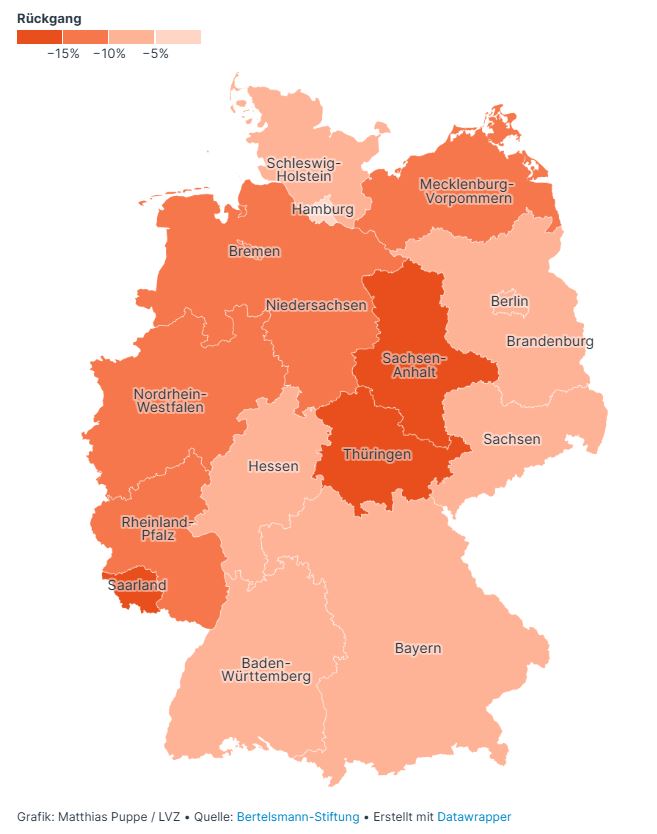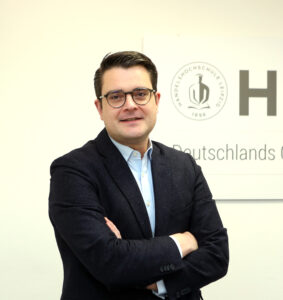Matthias Puppe
Gütersloh/Leipzig. Ohne deutliche Zuwanderung wird Deutschland in den kommenden Jahrzehnten einen erheblichen Teil seiner Arbeitskraft verlieren. Das geht aus einer am Dienstag veröffentlichten Studie der Bertelsmann-Stiftung hervor. Allein in Sachsen verringere sich der Anteil der Arbeitskraft bis 2040 um fast zehn Prozent. Parallel werden aber auch viele Arbeitsplätze im Osten verloren gehen, schreiben die beiden Autoren Alexander Kubis (Institut für Arbeitsmarktforschung) und Lutz Schneider (Universität Coburg). Von Hunderttausenden Jobs, die bis 2040 verschwinden werden, ist in der Studie die Rede.
Auch der Westen werde von dieser Entwicklung bis 2040 zwar nicht verschont, unter anderem als Folge von Digitalisierung und Dekarbonisierung. Allerdings prognostizieren die beiden Autoren beispielsweise in Bayern, Nordrhein-Westfalen und Baden-Württemberg parallel auch einen deutlichen Aufbau an neuen Jobs. Insgesamt verringere sich dort auch die Zahl der Arbeitskräfte, prozentual aber weniger als im Osten.
Bertelsmann-Studie: Entwicklung Arbeitskraftpotenzial 2040
ohne Zuwanderung

Auf den ohnehin eher „kleineren Arbeitsmärkten“ in Ostdeutschland gehen in den kommenden Jahrzehnten laut Studie sehr viele Potenziale verloren, dem demografischen Wandel geschuldet. Neben den zehn Prozent in Sachsen stehen jeweils 18 Prozent in Thüringen und Sachsen-Anhalt. Allerdings werde die Entwicklung nicht nur die Menge der Arbeitskräfte beeinflussen. „Das Erwerbspersonenpotenzial sinkt in den ostdeutschen Flächenländern zwar sehr stark, der Bedarf an Arbeitskräften sinkt aber ebenfalls in noch größerem Umfang“, schreiben die beiden Autoren.
Schrumpfung führt zu weiterer Schrumpfung
Grund dafür sei eine Art Abwärtsspirale, in der sich weite Teile Ostdeutschland befinden. „Eine stark schrumpfende Bevölkerung braucht weniger lokale Dienstleistungen und kauft weniger regional erzeugte Produkte. Diese geringere Konsumnachfrage führt zu einem geringeren Arbeitskräftebedarf in einer Region“, so Kubis und Schneider. Schrumpfung erzeuge immer weitere Schrumpfungen. Konkret ist beispielsweise für Thüringen von 180.000 wegfallenden Arbeitsplätzen bis 2040 die Rede, in Sachsen sollen es fast 300.000 sein. Nur in geringem Maße kämen bis dahin neue Stellen dazu.

Das führe trotz abnehmender Anzahl an Arbeitskräften zu einem Überschuss gegenüber dem tatsächlichen Bedarf in den Betrieben. In Sachsen ist für 2040 von 12,4 Prozent mehr Arbeitskraft als Bedarf auf dem Markt die Rede, in Sachsen-Anhalt sollen es demnach 18 Prozent mehr sein, in Brandenburg sogar fast 30 Prozent.
Studie: Betriebe verlagern Produktion – Arbeitskräfte wandern ab
In anderen, vor allem westdeutschen Regionen sehe die Zukunft diesbezüglich besser aus, nicht zuletzt aufgrund des nahezu gleichbleibenden Bedarfs an Arbeitskräften. Dies werde erneut innerdeutsche Prozesse anstoßen, vermuten die Autoren: Betriebe werden ihre Produktion aus Gebieten mit Fachkräftemangel abziehen, andererseits seien Menschen mobil und wanderten dann in Regionen mit hohem Bedarf ab – ähnlich wie es bereits in den 1990er und 2000er Jahren der Fall gewesen war.

Dieser innerdeutsche Austausch werde dennoch nicht ausreichen, um die insgesamt immer größer werdende Lücke auf dem bundesdeutschen Arbeitsmarkt auszugleichen. Konkret gehen die Autoren von einem Bedarf von 45,7 Millionen Beschäftigten im Jahr 2040 aus, ohne Zuwanderung stünden bundesweit allerdings nur 41,9 Millionen zur Verfügung.
Damit das Potenzial an Erwerbspersonen nicht derart einbreche, brauche es jährlich etwa 288.000 Zuwanderinnen und Zuwanderer nach Deutschland. Eingerechnet einer Arbeitslosenquote von drei Prozent gebe es so auch 2040 und 2060 noch genügend Arbeitskräfte im Land. Zum Vergleich: Im vergangenen Jahr haben bundesweit 350.000 Menschen Asyl in Deutschland beantragt, in diesem Jahr waren es bis Ende Oktober 218.000 Anträge. Allerdings wird fast die Hälfte aller Gesuche im Schnitt abgelehnt.
Die komplette Studie im Netz: www.bertelsmann-stiftung.de








